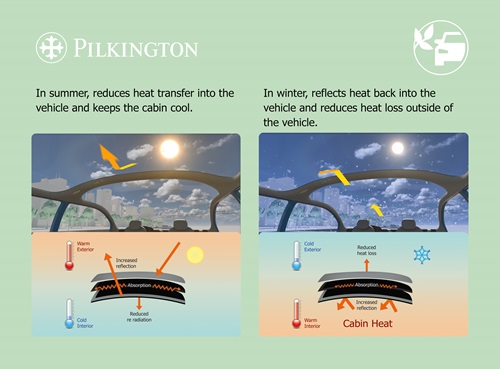A short journey through the development of automotive glass.
Since the invention of the car, automotive glass has undergone a rapid development. In the past, the main purpose of automotive glass was to allow a view on the road ahead and to protect passengers in the vehicle from wind and weather at the same time. Today, it has developed into a highly complex product. Compared to the 1970s, not only the average glass surface increased by around 40%, but automotive glass products in new modern vehicles can have up to 40 different functional properties now. Automotive glass is an elementary component in the development of new vehicles and enables exciting designs, a high level of safety and the use of innovative technologies.
Pilkington produces a comprehensive product range of different glass solutions and supports the ongoing innovation in the automotive industry, considering comfort, design, environmental and safety requirements. These include, for example, tinted and heated glass, variable transmission roof glass (Sundym Select™) or the integration of complex antenna systems, Head-Up Displays (HUD) and Augmented Reality Head-Up Displays (AR-HUD). Pilkington Low-Emissivity (Low-E) products also contribute to environmental protection by reducing CO2 emissions and increasing the range of electric vehicles. This is possible by actively regulating the temperature inside the vehicle through our Low-E glasses. Thus, the use of heating and air conditioning can be minimized without sacrificing pleasant temperatures in the interior.

Modern vehicles would be unthinkable without driver assistance systems (also known as ADAS = Advanced Driver Assistance System) such as adaptive cruise control (ACC), (emergency) brake assistant, pedestrian and traffic sign recognition or lane departure warning. Today, vehicle safety not only guarantees protection of vehicle occupants and those parties involved in accidents, but also focuses on active accident prevention. This is for example reflected in increasing requirements for a 5-star rating from Euro-NCAP and in comprehensive legal requirements actively driving the spread of driver assistance systems.
Many driver assistance systems have one thing in common: they are built on camera, radar, and LiDAR systems, which in most cases are installed at the windscreen. Camera-based systems are constantly evolving and in addition to a precise fitting shape and bending, they require a large distortion-free optical quality with tolerances in the milli-dioptre range. Pilkington's optimized bending processes combined with our expertise in each individual production step and strict quality controls guarantee this quality.
Every Pilkington product is certified and complies with the same high quality standards, regardless of whether it was produced for the aftermarket or for original equipment. This guarantees an easy installation of the glass, but also a successful calibration and unrestricted function of the driver assistance systems after a windscreen replacement.
Pilkington - More than just glass.